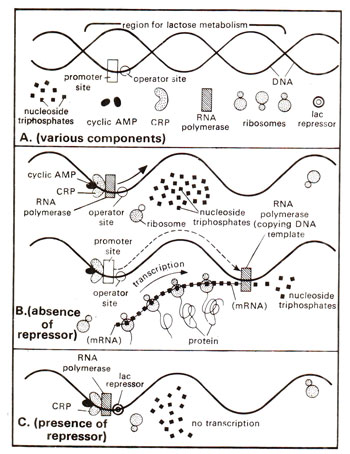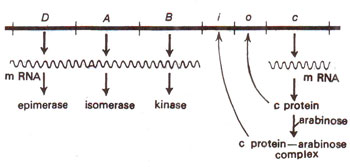Negative and Positive Controls of Transcription

Fig. 35.10. Mechanism involved in the positive control system for the regulation of gene activity in E. coli lac operon. Note that only in the absence of the repressor, RNA polymerase enzyme can travel and transcribe lac operon as shown in B. The repressor, when present on operator site is an obstacle in the path of RNA polymerase.

Fig. 35.18. A map of arabinose operon showing positive control of protein synthesis in E. coli.
In a positive control the regulator gene will stimulate the production of enzyme as in case of arabinose operon of E. coll. The gene without the activator will be inactive in this case (Fig. 35.18). Most systems on regulation, studied earlier, used a negative control. The positive control systems were studied only later.

Fig. 35.10. Mechanism involved in the positive control system for the regulation of gene activity in E. coli lac operon. Note that only in the absence of the repressor, RNA polymerase enzyme can travel and transcribe lac operon as shown in B. The repressor, when present on operator site is an obstacle in the path of RNA polymerase.

Fig. 35.18. A map of arabinose operon showing positive control of protein synthesis in E. coli.
In arabinose operon (also known as OBAD operon) shown in Figure 35.18, O, B and A are structural genes, i is the initiating site, O is the operator site and C is a gene comparable to regulator gene of 'lac' operon. Through the use of two mutations C- (which is characterized by reduction in transcription) and Cc (which is characterized by the constitutive synthesis of enzymes), it could be shown that the gene C gives rise to a protein P1 which works as a repressor in the absence of arabinose.




